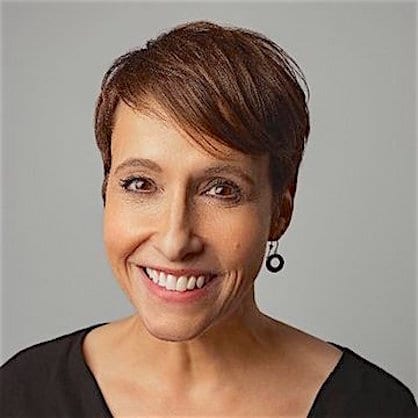Improving the human business of education
Jennifer Abrams has made it her life’s work to educate practitioners of education on ways to communicate and interact more effectively. As a world traveler, she has made an impact in schools, hospitals, and not-for-profit organizations; giving seminars and workshops to leading minds in the education space. Overall, educators leave inspired, ready to communicate and further improve learner outcomes.
Our conversation with Jen illustrates a unique perspective on how education is treated differently in other parts of the world. There are lessons to be learned in the United States by shaping our teaching practices to be more global in their approach.
Jennifer is a strong proponent of initiating healthy dialogue and cites a plethora of research which shows that if we ignore the importance of improved communication in education – and life – there is a financial price to be paid. Making an effort to lead positive conversations and meaningful staff development effects overall student achievement. There is value to funneling resources into evolving adult skills so that students can benefit from improved teaching environments.
To put it plainly, a failure to improve communication skills will cost a district – both literally and figuratively – in the long run.
Please enjoy the refreshingly honest, insightful and eye-opening interview with Jennifer Abrams below.
Interview
EdCircuit: Jen, I’ve had the privilege of talking to people all over education and around the world around their specific roles, which is fascinating because we learn about amazing innovation and leadership.
You travel far more than I do ─ even if I’m traveling virtually to meet these people ─ and you’re having really interesting conversations, meetings, and opportunities around things in education that we’re not privy to as the general public.
Let’s take that as a frame from the international perspective. A lot of times people are looking at the U.S. as a beacon. You get to go outside of the U.S. and have conversations on behalf of the U.S. in some form or fashion. What is it that you’re able to share with them about the challenges we’re facing, the benefits of our educational system, and some truths?
Jennifer Abrams: I do get a chance to work internationally. It’s a wonderful opportunity. I want to say that education in the U.S. is wonderful. We are here for public education. We are here to be innovative and to work with charter schools and to make things great.
I want to also caution everybody that if we consider ourselves only the place to look at or look to for information, it’s a disservice to us. I think we need to get out.
My opportunities in getting out and working in Canada, in European schools, independent schools, and in Asia have allowed me to see what our strengths are when it comes to creativity, empathy, and social-emotional awareness in the classroom. Our equity in the social and emotional might be really important and something we can highlight from the States.
But we need to look at other places for opportunities as to how they’re meeting the needs of English learners and how they’re meeting the needs of their students in so many different ways. And it’s important that we get out and we also highlight ourselves. I think it’s a balance.

EdCircuit: Are you finding that the topics of interest are very similar around the world? Are we more similar than not when it comes to the challenges that we face in education?
Data is data. Technology is technology. But as human beings, we’re very fluid in our development, in our relationships, and the challenges that we face. Are you seeing any similarities in some of the topics that are discussed or inquired about regarding your experience in the States, maybe that they learn from outside of the U.S.?
JA: I think that data is data and technology is technology. If you’re going to Asia, you’re going to see just the immediacy and the quickness of data, and the quickness of technology happens instantaneously. Their phones are faster than our phones. They’re keeping up with things technologically that we’re starting to do. And it depends on where you are in the U.S. as to whether technology has come in.
I also see them interested in our student voice, the fact that students are agents in their learning, the fact that we’re modifying things for people. That we are offering to them and they’re offering things to us.
I think that human beings are human beings. But culture makes a tremendous difference in what people value, in what people consider to be the places of emphasis in their teaching, and where they see their students and their citizens going, and in what they want to teach.
So I think we can’t say everything is the same. I think cultural filters make a very huge difference in what they do.
EdCircuit: They do. It makes me think about an overused term and I want to ask you about this: Where should we place the pause button?
To me, one of these is around personalization. We’re sort of hell bent on personalizing learning for the learner but we don’t often talk about the impact of that from a cultural perspective with regards to faculty or educators and building leaders or designated leaders.
If we sort of fly in, metaphorically, to the U.S. to talk about that, where do we place the pause button on efforts that we have for students that we also should be thinking about with regards to our staff development and support of that. Then we can learn something and, in tandem, be attacking both challenges?
JA: I think personalized learning is where it’s headed in a lot of schools across the world. I think that more independent schools ─ just to bring them up, GEMS schools, Cognita schools, other for-profit schools ─ have a lot of resources. They can provide that personalized learning to the students.
There really needs to be a conversation about what we can do and what is doable financially. I get that we’re going in that direction. I am all for personalizing and coaching toward the leaders that we’re working with.
What do different people need in order to grow themselves? I don’t think we have taken that differentiated mode, and that optimal learning experience concept from the student work, and moved it to the teachings in terms of PD, in terms of coaching, in terms of creating just-in-time learnings.
Technology has helped, but I really think it’s a human endeavor and we’ve got to work on trying to figure out how to support each teacher where they are.
EdCircuit:I think that becomes the challenge. There’s a discussion about resources regarding public versus private. But here’s what I think could be compelling for folks listening to us ─ we’re talking about coaching, right? Part of the problem, would you agree, is that they have to recognize that they have a need to better their communication skills, and to also identify the challenges that face their school, their district, and their classroom?

Look, education by its very nature ─ I say this as two educators speaking to each other ─ has been, sometimes, slow to accept change. How do we have a conversation around something if there’s an elephant in the room in an ongoing way?
Some of these things that we’re talking about, whether it’s funding issues that superintendents talk about or poor software integration, a lot of that could be helped or solved if we had better coaching, if we had better ways to integrate them in. But there has to be some recognition by the users to be able to say, “We need some help.”
Now, I think we’re seeing amazing growth and trends in the private sector integrating in coaching models and leadership development where it’s really accepted to have these kinds of conversations and that it is something that is open and a part of your professional learning.
Where are we? What’s the state of the union in education?
JA: I think that what happens in business is driven by a bottom line. I think that they have discovered and done much research ─ Harvard Business and many other places have been doing a lot of research ─ basically saying that there is a cost to not doing the communication effectively.
We are not in a for-profit business most of the time. And so, we like to turn away from looking at that research and saying, “We need this.”
What’s interesting is that we’re in a human business. In a human business we think we already have our communication skills down. We didn’t get into this business if we weren’t nurturing. We’re already very good at it. And how did we get to leadership positions without knowing how to communicate, right? I mean, it’s facetious, right?
I think that once you get into those jobs, the challenges are different. Facilitating adults is different than teaching students. And so, how do we grow adults?
That is a whole other skill set that we, as educators, need to put our money behind in order to realize the potential we’ve got. There’s also so much research on trust. And I want us to actually consider that building trust is a conversation over and over again. And if we built trust and if we built efficacy in our collaboration, we could increase achievement.
We can look at so many people’s research on that. It’s secondary, supposedly, to the classroom practice. But if we do not get our conversations in order, student achievement will not go up. It is time that we put our money into helping adults grow each other and helping adults grow themselves.
EdCircuit: So this is really a discussion around economics. This is being on an airplane knowing that you put yourself on the air mask before you do your child.
So how do we, then, convince a district or a school that an investment in their staff development around coaching and mentoring and career growth and opportunity is beneficial also to the student at the end of it?
JA: Right. I think if we ─ just for an example ─ look at the meta-analyses of John Hattie, his newest work talks about collective efficacy. Jenni Donohoo from Ontario, Canada, talks about collective efficacy. Bryk and Schneider talked about trust in schools in the early 2000s.
There isn’t anybody who doesn’t realize ─ and there’s been research on it over and over again ─ that if adults can work collectively and more effectively together, student achievement will go up.

But if we can figure out how to talk to each other and trust each other and respect each other ─ “Hey, Rod, what’s your idea on this?” or “Hey, Jennifer, what’s your thought?” ─ and we respect the competence and we know how to talk to each other, we might get an idea that will change our practice.
I think that we have done a lot of professional learning communities. I’m very pro-PLC. What I think we need to do, though, is learn how to be professional, learn how to be learners, and learn how to be a community.
I’m not sure that we learn that when we learn about getting together to talk about student work. I think there’s a prerequisite that we need to really work on which is “How do we work with each other?” If we did that ─ I can’t definitively tell you that student achievement will go up ─ but, I can tell you that school morale will go up. The climate will get better. And we’ll get a better chance of finding, amongst each other, the supports we need to go back in the classroom and to improve student performance.
EdCircuit: Jen, let’s close with this. Are there identifiable markers that you are seeing in districts or schools that reach out to you, that are interested in learning about ways to better enhance communication skills amongst teachers and between school leaders, that we can learn from, that identify in the same that a husband and wife would say, “Look, we’ve got a great family but we want to continue to better ourselves in service of our children and our family.” There’s a level of recognition and awareness that you can point to that says, “Yes, this is going to be a group that I like to work with. This is a group that says to me they are progressive and they understand the work force”?
JA: I just want to put in a plug. This is so prescient. The Lake Washington School District up in Redmond, Washington, has invited me to join them and partner with them to do pretty much what you’re saying. They have a set of teachers on special assignment ,all in coaching roles across a variety of departments ─ from assessment to highly capable students to technology to professional learning to English learners. And all their coaches said, “We need a common language because we want to play. We are very high performing.” They are very excellent school districts. That’s not the issue.
“We want to make it even better. So what types of things can you teach us so that we can help and grow and support our teachers even more effectively?”
So I’ve gone in and talked to them about generational savvy; about communicating across ages; communicating across other filters, race, and gender; about understanding adult learning and adult development, developmental theory and really helping them up their game.
And then, the professional learning folks asked me to come in just for them alone and they actually said, “We want to grow our practice in being the best we can be. Figure out what that is.”
And I said, “Great!”
So we’re going to do some pre-assessments to figure out where they’re at and where they can go because they want to even be as brilliant in their communication and in their support as they can get.
It is a hugely interesting and important thing for adults to be able to do. We have to grow ourselves just as much as growing our students.
EdCircuit: That’s a great place to end. I agree with you. I think that it’s pretty exciting to think that you’ve got a group that’s basically saying, “Let’s get out the markers. Let’s get a whiteboard. Let’s talk about these things,” in a world where we want to stick to our tests and our data and our boxes to check. That, to me, is very refreshing for people who might feel stagnant in their current district or situation.
JA: They are extraordinary and they are thinking 2.0: What’s the next level? It’s really cool.
About Jennifer Abrams:
 Jennifer Abrams is an international educational and communications consultant for public and independent schools, hospitals, universities and non-profits. Jennifer trains and coaches teachers, administrators, nurses, hospital personnel, and others on new employee support, supervision, being generationally savvy, having hard conversations and effective collaboration skills.
Jennifer Abrams is an international educational and communications consultant for public and independent schools, hospitals, universities and non-profits. Jennifer trains and coaches teachers, administrators, nurses, hospital personnel, and others on new employee support, supervision, being generationally savvy, having hard conversations and effective collaboration skills.
Jennifer considers herself a “voice coach,” helping others learn how to best use their voices – be it collaborating on a team, presenting in front of an audience, coaching a colleague, supervising an employee and in her new role as an advisor for Reach Capital, an early stage educational technology fund. Jennifer holds a Master’s degree in Education from Stanford University and a Bachelor’s degree in English from Tufts University. She lives in Palo Alto, California.
Follow Jennifer Abrams on Twitter
This interview was originally published in the Huffington Post.
- New York Times – U.S. Crackdown on For-Profit Schools Is Said To Go Idle
- USA Today – Loosening of for-profit school rules worries student advocates
- Corwin Connect – Fostering Collective Teacher Efficacy: Three Enabling Conditions
